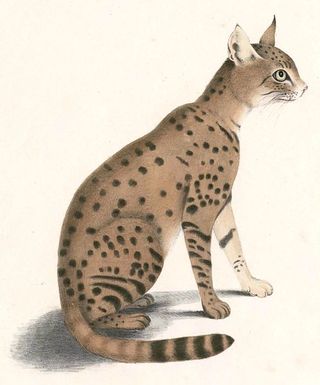Genetics
Domestication, It's Complicated
The DNA of ancient cats reveals a tangled history
Posted June 19, 2017
The story of how our domestic animals came to be, once the province of archaeologists, has been considerably enriched by studies of their DNA. Cats are a case in point: although the archaeological evidence pointed emphatically to domestication in Egypt some 5,000 years ago, Carlos Driscoll’s DNA analyses revealed a much earlier separation from the parent subspecies, Felis silvestris lybica, and not in northern Africa, but in Anatolia or the Levant. Comparisons between the DNA of today’s cat breeds and those of their wild counterparts show that all are descended from the same Middle-Eastern stock, even the lithe oriental breeds that superficially resemble the Eastern subspecies, F. s. ornata. In this week’s edition of Nature Ecology & Evolution, Claudio Ottoni has now published the most comprehensive survey of ancient cat DNA to date, and in so doing has clarified some of the cat’s history, while at the same time adding new mysteries.
Extracting and characterising DNA from museum specimens is not easy, and this study has inevitably focussed on the most tractable sequences, single-nucleotide polymorphisms (SNPs) found in mitochondrial DNA (mtDNA). This form of DNA is passed unchanged from mother to daughter – except for the rare occasions when a mutation occurs – so while it is useful for tracing geographical origins and distinguishing subspecies and long-standing lineages, it says nothing about the contribution of males to the genetic mix. To use a human analogy, in so far as your mtDNA is concerned (whether you are male or female) you are identical to your maternal grandmother: no trace of your other three grandparents remains, whereas of course your nuclear DNA consists of a unique permutation of all four.

The new study shows that today’s domestic cats have two sets of maternal ancestors, one (lineage IV-A*) originating in Anatolia, and another (IV-C) which first appears in any numbers in Egypt. Unfortunately African specimens older than 800 BC failed to produce any analysable DNA, so it’s difficult to say whether IV-C had originated there hundreds or thousands of years earlier, or had been transported there from somewhere else. However the most likely interpretation, given the archaeological evidence, is that there were two domestications of cats, the first based on a commensal relationship between early farmers in Anatolia and the Levant and semi-tame cats that were valued as pest controllers, and the second, several thousand years later, in or near Egypt, which produced cats that were much more easily to socialise than their cousins from further north.
The likelihood of this second domestication event is strengthened by the DNA of one of the Egyptian cat mummies analysed, which showed it had Anatolian ancestry. This suggests that the Egyptians may have already imported the IV-A* pest-controller cats centuries earlier, but then found that they could develop their own, friendlier version from their local wildcats. Subsequently, it would have been impossible to stop the two types interbreeding wherever they encountered one another, so that today’s pet cats all contain DNA from both origins – the distinction now only of historic significance, traceable through the maternal line.

While many of the cats analysed in this study conform to this overall picture, a few individuals do not, suggesting that in the past domestic cats may have been a more diverse bunch than they are today. Most intriguing are those cats from the Red Sea port of Berenike (1st-2nd century CE) and Turkey (6th-7th century CE) whose mtDNA is not from F. s. lybica at all, but from the Indian/steppe subspecies F. s. ornata. Evidently while some cats moved eastwards along the medieval trade routes and eventually metamorphosed into the oriental breeds, others moved westwards and flourished for a while, although they may never have penetrated into Europe and so failed to make a significant contribution to today’s pedigree cats.
The domestic cat’s prowess as a hunter, so highly valued historically, has recently attracted much adverse publicity, especially in Australasia and in the United States. Perhaps in the future it will be possible to breed cats that lean more towards the sociable Egyptian type than the more self-reliant and independent Anatolian.


